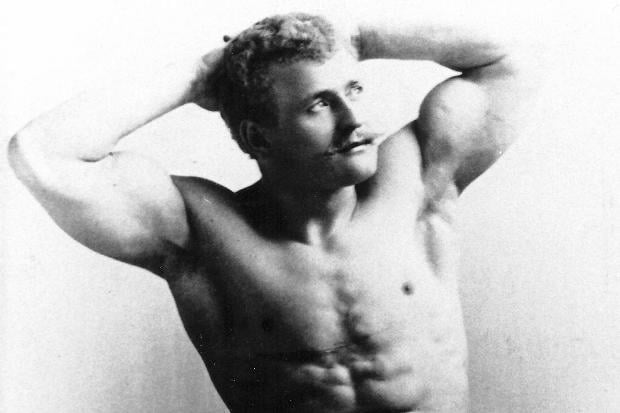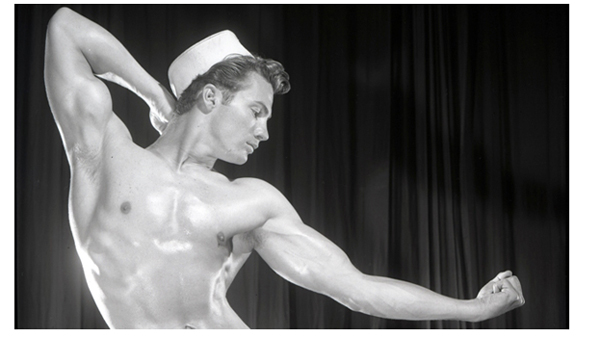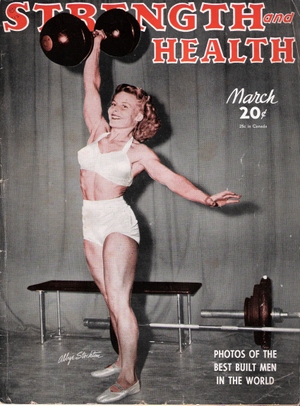Ideals of male beauty have changed over centuries
Though male physique photography pioneer Bob Mizer set out to define masculinity in post-war America, his idea of the perfect male body was a...
3 min read
Bob Mizer Foundation : Apr 19, 2016 4:26:00 PM

Before the models of Bob Mizer’s Athletic Model Guild redefined masculinity to a puritanical American audience, there was the original ‘strong man,’ Eugene Sandow.
Known as the father of modern bodybuilding, Sandow was born in Prussia in 1867. Originally, his parents wished for their son to become a priest, but Sandow found that his natural athleticism and good looks made him popular among the girls in his town. At the urging of a mentor, Sandow entered a ‘strongman’ competition at the age of 22. Although he began performing throughout Europe as a bodybuilder who displayed feats of strength such as lifting barbells, the entertainment producer Floernz Ziegfeld (later of the famous ‘Ziegfeld Follies’) encouraged Sandow simply to stand onstage and pose for the crowd.
Throughout his early career, Sandow was photographed extensively, his image easily recognizable on cabinet cards, a style of photo used primarily for portraiture beginning in the early 1870s. Cabinet cards essentially were photographs mounted on heavier cardstock, usually measuring roughly 4 inches by 6 ½ inches. These cards reached their peak in popularity in the 1880s, as Sandow’s bodybuilding career began. Due to personal photography becoming more common among consumers, these cards began to decline in popularity as Sandow’s own popularity grew. In addition to cabinet cards, one could easily find color illustrations of Sandow’s mustachioed visage beaming on the inside of cigar boxes, on postcards and on vaudeville posters.
In the late 19th century, Americans and Europeans were beginning to discover the myriad benefits of good physical health, and Sandow was the pure picture of it – quite literally, according to David Chapman, author of several books on physique photography.
“The late 19th century was a time when people were discovering sports in a big way, and a lot of new sports were born at that time,” Chapman said in a 2013 interview. “Bodybuilding was just one of them. This happened mainly through the work that Eugen Sandow did, making bodybuilding popular. He didn’t invent the sport, but he made it widespread because he was an international vaudeville star. Men were inspired by him, and they wanted to have a body like his. Sandow said, ‘I can show you how that’s done for a small fee,’ and that’s how it got going.”
Den Bell, founder and president of the Bob Mizer Foundation, said Sandow’s bulging muscles and v-shaped waist did more than simply promote physical fitness. The mere display of Sandow’s musculature was enough to woo audiences.
“The 1890s to the 1920s was the period when people began visiting the gym on a regular basis, but Eugene Sandow was probably the first bodybuilder whom people just wanted to gawk at because he was, put simply, quite easy on the eyes,” Bell said. “Aesthetics were just as much a part of Sandow’s appeal as his pursuit and encouragement of good health to men.”
Sandow’s big breakout year was 1894, when Ziegfeld brought the young bodybuilder to the U.S. for the World’s Columbian Exposition in Chicago. There, Sandow met his largest live audience to date. His performance was a smash hit, and he and Ziegfeld spent the next few months traveling across the U.S., with Sandow performing stunts such as lion fighting (which was, according to legend, rigged in Sandow’s favor, since the lion he fought was drugged and his sharp claws covered with mittens).
As a media darling, Sandow was among the first people to appear in some of the first motion pictures. He was hired by American inventor Thomas Edison’s fledgling film studio in the mid-1890s to appear in a short film. Sandow did nothing in the film but flex his muscles and pose for the camera. It was more than enough for audiences of the extremely new medium, who would have been satisfied to watch just about any pictures move on a screen, regardless of the action that was occurring. In addition to working for Edison, Sandow later appeared in a Kinetoscope film that was part of the first commercial motion picture festival in the history of the medium.
The dawn of the 20th century provided even more opportunity for Sandow to act as a pioneer in the field of bodybuilding. In 1901, Sandow organized the first major bodybuilding competition in London, where so many physique enthusiasts flocked to the venue that many had to be turned away at the door. Capitalizing upon the success of the competition, Sandow traveled around the world for the next two decades, touting his bodybuilding routine, exercises and techniques.
Sandow died in 1925 at the age of 58. While no official cause of death was announced, since no autopsy had been performed, journalists speculated that his demise was due to a brain hemorrhage brought on after straining himself when he tried to lift his car out of a ditch following a traffic accident several years before.
“It’s interesting to think that something as routine as going to the gym every day can be traced back to Eugene Sandow and his popularity,” Bell said. “It’s easy to see, then, why he’s been dubbed ‘the father of modern bodybuilding.’”

Though male physique photography pioneer Bob Mizer set out to define masculinity in post-war America, his idea of the perfect male body was a...

“Big Brother believes it is essential to tell you and me what is suitable for us to read and see—-apparently we lack the wisdom and discernment and...

Unlike obese men nicknamed ‘Slim’ or tall men nicknamed ‘Shorty,’ Abbye Eville’s nickname in childhood was anything but ironic.
 Read Press Release
Read Press Release